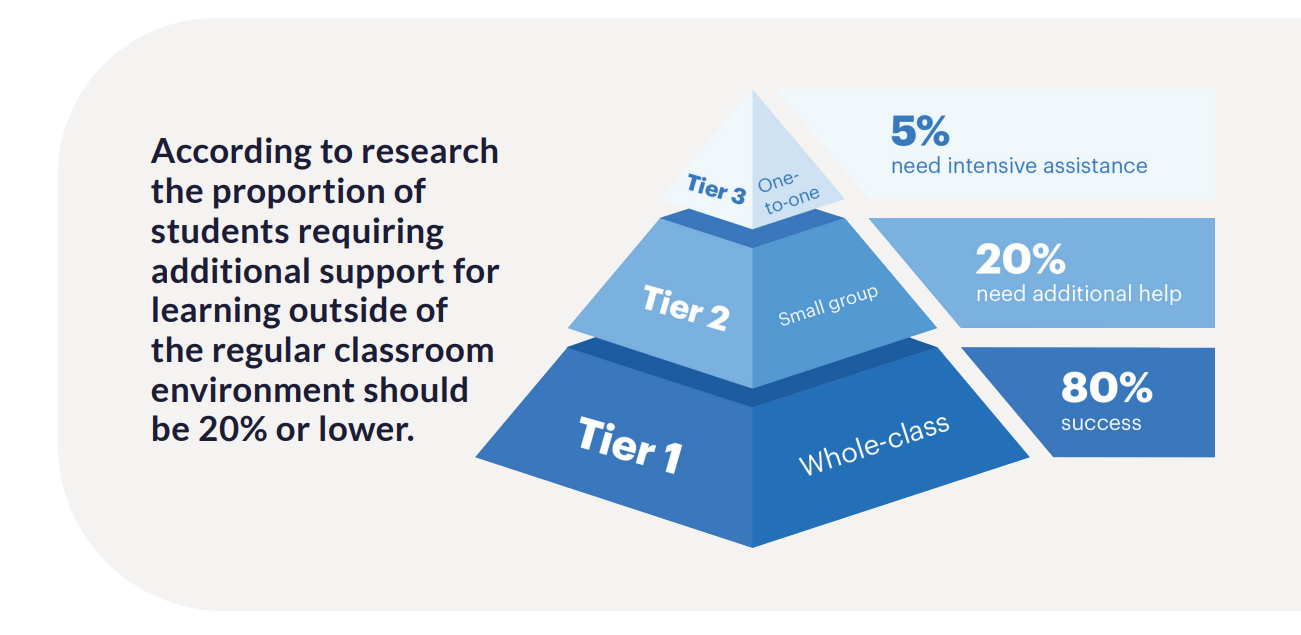Released on Monday, the report by researcher and program developer MultiLit drew on the views of more than 600 teachers and teacher aides in Australian schools.
Almost 80 per cent of schools were found to fall short of the accepted 20 per cent target of Foundation to Year 2 students who need further literacy support – a target that sits within a Multi-Tiered System of Support (MTSS) framework.
More than 60 per cent of educators claimed up to 40 per cent of their school’s students required further intervention, and 10 per cent said this was more than half.
Alison McMurtrie, literacy specialist at MultiLit, said schools were under enormous strain as they try to meet the intervention needs of so many students.
“When schools provide high quality, evidence-based literacy instruction, the proportion of students requiring additional support should be 20 per cent or lower,” McMurtrie emphasised.
“For those students who do struggle, learning support via what is known as Tier 2 small group instruction can be very effective in helping them to catch up.
“This sort of intervention is a necessary part of every school, but it can be resource-intensive and difficult to sustain, particularly in cases where 20, 30, or even 40 percent of students need extra help…”
The report flags that running large numbers of intervention groups presents logistical issues, such as securing classrooms for small groups, coordinating schedules to minimise disruption to students’ classroom learning and aligning teacher availability.
“It’s hardly surprising that two-thirds of teachers are saying their schools simply don’t have the resources to operate large numbers of intervention groups, even when they have access to a good intervention program,” McMurtrie said.
The report urged that improving outcomes ‘starts with getting classroom teaching right’.
“Good intervention programs can help prevent children from falling off the cliff, however quality classroom instruction is what stops them getting close to that cliff edge in the first place,” it read.
“Providing explicit and systematic classroom-wide instruction of the core skills that support literacy development, including phonics, is the most effective approach to teaching reading.”
 SOURCE: MulitLit
SOURCE: MulitLit
The study also found that the instructional approach between schools varied widely.
While 62 per cent of participants reported their school follows structured literacy (involving highly systematic and explicit instruction, including synthetic phonics and use of decodable texts), some 38 per cent said less effective methods were used to teach literacy at the whole class level.
While just one per cent of participants said their school relied solely on discredited balanced literacy, 29 per cent used a mixture of structured literacy, balanced literacy and literacy embedded within inquiry units.
Professor Pamela Snow, professor of cognitive psychology at La Trobe University, previously told EducationHQ that balanced literacy was an “inherently murky concept” that “actively promotes eclecticism” in the classroom.
“…no one can define it, and you get to do pretty much whatever you like, because anything is in scope if you’re doing balanced literacy.
“As long as you’re doing some sort of phonics, some sort of vocab work, some sort of comprehension, fluency work, it doesn’t really matter how you’re doing it…” Snow said.
The latest NAPLAN results show one in three students are still failing to meet proficiency benchmarks in reading.
McMurtrie said these findings only highlight the need for “ongoing refection” on teachers’ instructional practices, because nailing this, as a starting point, is key.
“Fewer than one in five children who are behind in literacy in Year 3 catch up and stay caught up throughout their schooling, and this has huge implications on their success and wellbeing throughout school and their life opportunities more broadly,” she added.
The survey also revealed a disjunction between many schools’ perceptions of how well their literacy strategy was working and the significant number of students in need of more support.
Almost two-thirds of educators rated their school-wide literacy strategy as ‘good’ or ‘excellent’, despite evidence of high numbers of students in need of additional intervention and a widespread inability to cater to the needs of these children.
Just one third recognised that their school’s literacy strategy needed improvement.
The report warned that schools could be compromising their literacy curriculums by mixing and matching from different programs or developing their own from scratch.
One in ten respondents said each teacher in their school designs their own literacy curriculum, with 54 per cent reporting their colleagues worked together to create a shared curriculum – be that designed from scratch (6 per cent) or by combining elements from different programs.
Only 17 per cent of schools were found to rely on a single program to provide literacy instruction to students.
Teachers involved in the study were from schools who had adopted a MultiLit Tier 2 intervention program but were not signed up to InitiaLit – a Tier 1 program for whole-class literacy instruction.
Thus, the report warns that the national picture could be worse.
“Too many children are missing out on the chance to reach their potential or worse, are at risk of falling through the cracks completely,” it stated.














